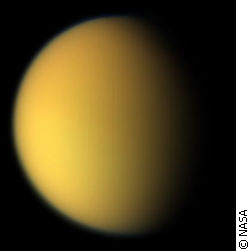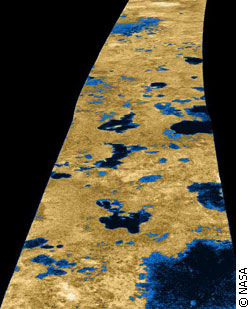
|
|
If life does exist on this orange moon, called Titan, it would likely be so tiny it would be difficult for us to see. It would either have to crouch in water that hides beneath the surface, or somehow adapt itself to a place with rivers and lakes of methane and octane rather than water. The problem is, today's scientists don't even have the tools to search for it. “I think it would be fair to say there’s a great deal of interest in Titan having life or the ingredients of life,” says Paul Delaney, a physics and astronomy professor at York University. He studies stars for a living, but in his spare time reads all he can about the planets and moons closer to home.
“The thing is, we don’t have any information in the near future to look for life. The spacecraft we have today are not equipped to find it. Scientists don’t like to speculate. They work with the facts, and there are a lot of interesting facts about the physical processes of Titan that we do know.” A National Aeronautics and Space Administration (NASA) spacecraft called Cassini has been weaving its way between Titan and other moons around Saturn for the past two years. Powerful radar and sensitive instruments allow it to probe below Titan’s clouds and map the surface. Cassini and its landing craft Huygens, which made it to Titan’s surface in December 2004, are producing a string of remarkable discoveries that make Titan seem an Earth-like place to live. Global chemistry ground control But the key is finding out if liquid water does exist. Maps of the once-shrouded surface appear on NASA’s website every month as Cassini flies by Titan again and again. In January, scientists announced the spacecraft found methane lakes on Titan’s surface. Less than a month later, the team says they had found a large methane-filled cloud near Titan’s north pole – close to where those lakes were found. Lakes, clouds, liquid and weather – these are all things that are abundant on our own planet. “It’s a chemistry laboratory that we can’t replicate on Earth, certainly for the few years that scientific research has been done,” says Larry Soderblom, a member of the Titan scientific team who works for the U.S. Geological Survey. “But to be honest, Titan does not have life that we have much of a chance of seeing. It’s too cold and as far as we can tell, it does not have liquid water. You can argue that even if the surface is too cold, Titan could have liquid water in the same way that we have liquid rock on Earth: beneath the surface . . . But this leads to a different question: whether Titan can support life or whether it can evolve from non-life to life.” Is there life on Titan? However, scientists such as Steven Benner – a former professor who has since created the Foundation For Applied Molecular Evolution – argue our definition of life may be too focused on what the Earth’s life is like. Benner was the head of a University of Florida scientific research group that looked at the biology, chemistry and evolution of life processes like proteins – substances that control physical changes in our body.
Benner’s research focuses on understanding these processes in earthly life, the only known life in our universe today. Life as we know it depends on water to survive. Water is a “polar” molecule, meaning that it has an electrical charge to it. The negative charge in the water bonds it to the positive charge of other molecules in the water like salts. When water bonds with these salts and similar items, they dissolve. Methane is not a polar molecule. This means it can’t bond to salts and other things in its liquid state as water does. This is extremely important when considering life functions: how nerves transmit signals up the spine to the brain, or how DNA works. If the salts cannot dissolve, the nerves would be useless and the DNA would not be able to transmit genetic information to our cells. Still, Benner maintains it is possible for life to survive in other environments where water is not the dominant substance. “We are working to create alternative Darwinian systems based on fundamentally different chemistries,” he says in an August 2005 Nature news feature that partially discussed Titan. “We are using different solvent systems as a way to get a precursor for life on Earth.” Was early Earth blue? Another scientist on the Titan team, the University of Arizona’s Jonathan Lunine, remains skeptical that life exists on Titan. The best way of comparing Titan to Earth is to say one world is similar to the other, but not exactly the same, he says.
“Life has not begun on Titan,” says Lunine. “But it is closer to the prehistoric Earth than the Earth we have today.” The lakes and clouds his team discovered prove Titan has a weather system that is similar to Earth – a fact that excites scientists on the landing team. But Delaney says it is difficult to keep the public interested in such findings. “A scientist wants to be able to convey excitement on a range of issues, including some that are dull, boring and yawning,” he says. “Yet it’s some of those attributes that relate to what the public wants to hear. We want them to recognize there is a lot of research that can lead to finding life . . . without misleading the public.” In the meantime, Cassini will fly by Titan twice in April and several more times before the end of the year. Even though life is not one of the things it will find, the possibility of it will keep both scientists and the public interested, says Delaney. “If extremeophiles can survive in the harsh conditions of Mars and Titan, there is the possibility of life being common in the universe.”
|
|
|

